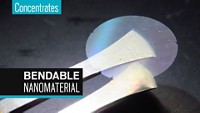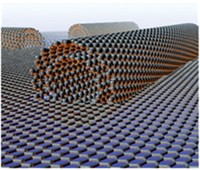Advertisement
Grab your lab coat. Let's get started
Welcome!
Welcome!
Create an account below to get 6 C&EN articles per month, receive newsletters and more - all free.
It seems this is your first time logging in online. Please enter the following information to continue.
As an ACS member you automatically get access to this site. All we need is few more details to create your reading experience.
Not you? Sign in with a different account.
Not you? Sign in with a different account.
ERROR 1
ERROR 1
ERROR 2
ERROR 2
ERROR 2
ERROR 2
ERROR 2
Password and Confirm password must match.
If you have an ACS member number, please enter it here so we can link this account to your membership. (optional)
ERROR 2
ACS values your privacy. By submitting your information, you are gaining access to C&EN and subscribing to our weekly newsletter. We use the information you provide to make your reading experience better, and we will never sell your data to third party members.
Materials
Tough, self-monitoring composites inspired by nacre
Crack-resistant and conductive material could find use in aircraft and car parts
by Prachi Patel, special to C&EN
October 1, 2019

Nacre, the iridescent material that mollusks make to line their shells and coat their pearls, is exceptionally tough. Inspired by nacre’s microscopic structure, researchers have now made a composite of graphene and an epoxy resin that is lightweight and much more resistant to cracking than similar composites made so far (Matter 2019, DOI: 10.1016/j.matt.2019.08.013)
What’s more, the new composite is conductive, which makes it useful for self-monitoring automobile, aircraft, and wind turbine parts. The tiniest crack would disrupt the material’s conductivity, a property researchers could use to build self-monitoring structural materials that sound a warning before the fractures get bigger and cause catastrophic failure.
Nacre’s mechanical properties arise from its brick-and-mortar structure. The material is composed of platelets of brittle calcium carbonate arranged in layers held together by organic biopolymers. The layered structure thwarts cracks in multiple ways: the hard platelets can bear a lot of force, they can slide on one another, and the layers make cracks move in a zigzag fashion, which absorbs energy and prevents damage.
Researchers have copied this structure by mixing platelet-mimicking clay particles, carbon nanotubes, or graphene flakes in an epoxy matrix in place of the biopolymer. Graphene is particularly promising for these composites because of its high strength. But it doesn’t mix well with epoxy, instead tending to clump together. These lumpy composites don’t resemble the brick wall–like structure of natural nacre, and their mechanical properties are poor.
Qunfeng Cheng, a chemist at Beihang University, and his colleagues use a method called ice templating. They mix graphene oxide flakes and cellulose gum in water to make a thick suspension . The gum keeps the graphene sheets flat and sticks them together. Then they freeze the container along two directions, causing ice crystals to spread slowly outward from one edge of the container in the form of parallel walls. As the walls grow, the graphene oxide sheets and cellulose gum get trapped in between, getting squished together to form parallel membranes.
The researchers vaporize the ice, heat the membranes to reduce the graphene oxide into graphene, and then fill the gaps between the membranes with an epoxy. The evenly spaced graphene membranes make the material nacre-like in structure and toughness, says Cheng. Testing showed that the material is 3.6 times as tough as the plain epoxy itself and about twice as tough as previous epoxy-nanoparticle composites.
The material is also electrically conductive. The researchers measured the electrical resistance across a 14 mm-long sample as they flexed it. The resistance slowly increased with bending and spiked when the first microscopic cracks begin, suggesting the material could be used to build structures that can monitor their own health by generating an electrical signal at the first hint of mechanical failure.
Making large samples of epoxy-graphene composite has been a challenge, Cheng says. The largest samples they can make with the ice-templating technique using their current equipment are about 2 cm long. The method should be amenable to industrial scale but needs much more work, he adds. “The challenge on larger scale is to control the growth of ice without any defects,” he says.
The material looks a “lot more uniform than previous works and is amazingly similar to nacre,” says Jiaxing Huang, a professor of materials science and engineering at Northwestern University. “This is so far the most beautiful microstructure of such composites I have seen.” He envisions the material being used to make electronic components on lightweight drones.
The team now wants to mimic nacre even more closely to further boost the toughness of the composites. Nacre is about 96% calcium carbonate (the platelet material) by weight, whereas the composite is around 1% graphene plates. By decreasing the thickness of the epoxy layers to more closely match that of the calcium carbonate platelets, the researchers believe they can make the composite even tougher.





Join the conversation
Contact the reporter
Submit a Letter to the Editor for publication
Engage with us on Twitter